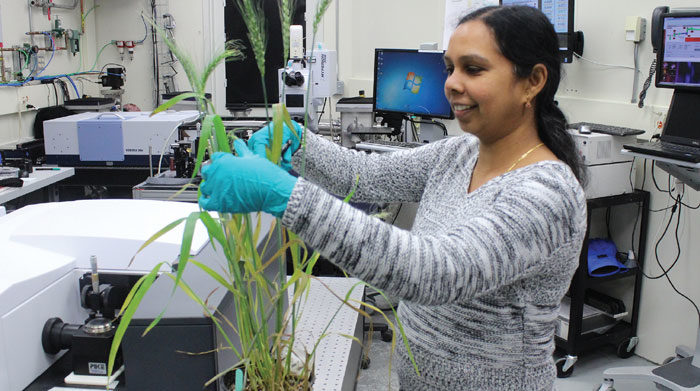No-Till Farmer
Get full access NOW to the most comprehensive, powerful and easy-to-use online resource for no-tillage practices. Just one good idea will pay for your subscription hundreds of times over.

Chithra Karunakaran, manager of Environmental and Earth Sciences at Canadian Light Source (CLS), works at the mid-infrared (mid-IR) beamline. Researchers used the mid-IR tools at CLS to measure the amount of plant matter decomposed in soil following the addition of calcium. Photo by: Canadian Light Source
No-tillers adding calcium to their fields to adjust pH or improve soil structure are likely encouraging beneficial populations of microbes that help sequester carbon in the soil
The revelation stemming from the University of Saskatchewan’s national synchrotron research facility — known as the Canadian Light Source (CLS) — could lead to more strategic use of calcium in agriculture.
The CLS is equipped with state-of-the-art light-emitting equipment designed for research and unique measurement projects. The facility hosts more than 1,000 researchers from around the world each year to use the equipment for their studies in agriculture, environment and advanced materials. In this case, researchers from Purdue and Cornell Universities collaborated with the U of S using mid-infrared measurements to establish changing amounts of stabilized organic carbon.
Calcium Effect. Lead researcher Itamar Shabtai, an assistant scientist with the Connecticut Agricultural Experiment Station doing post-doctoral research for Cornell, says scientists were aware calcium had effects on the way organic matter is stabilized in the soil.
“What wasn’t known was whether calcium had an effect on which microbes were involved and how they acted,” he says. “We showed that by adding calcium to the soil, we changed the community of microbes present and the way they behaved.”
Shabtai says adding calcium made the microbes more efficient in stabilizing soil-borne carbon into organic matter, resulting in more carbon retained in the soil and less lost to the atmosphere as carbon dioxide. Carbon makes up about half the organic matter in the soil and is very…